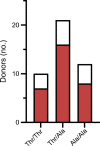Detection of enterovirus RNA in peripheral blood mononuclear cells correlates with the presence of the predisposing allele of the type 1 diabetes risk gene IFIH1 and with disease stage
- PMID: 35867130
- PMCID: PMC9477938
- DOI: 10.1007/s00125-022-05753-y
Detection of enterovirus RNA in peripheral blood mononuclear cells correlates with the presence of the predisposing allele of the type 1 diabetes risk gene IFIH1 and with disease stage
Abstract
Aims/hypothesis: Enteroviral infection has been implicated consistently as a key environmental factor correlating with the appearance of autoimmunity and/or the presence of overt type 1 diabetes, in which pancreatic insulin-producing beta cells are destroyed by an autoimmune response. Genetic predisposition through variation in the type 1 diabetes risk gene IFIH1 (interferon induced with helicase C domain 1), which encodes the viral pattern-recognition receptor melanoma differentiation-associated protein 5 (MDA5), supports a potential link between enterovirus infection and type 1 diabetes.
Methods: We used molecular techniques to detect enterovirus RNA in peripheral blood samples (in separated cellular compartments or plasma) from two cohorts comprising 79 children or 72 adults that include individuals with and without type 1 diabetes who had multiple autoantibodies. We also used immunohistochemistry to detect the enteroviral protein VP1 in the pancreatic islets of post-mortem donors (n=43) with type 1 diabetes.
Results: We observed enhanced detection sensitivity when sampling the cellular compartment compared with the non-cellular compartment of peripheral blood (OR 21.69; 95% CI 3.64, 229.20; p<0.0001). In addition, we show that children with autoimmunity are more likely to test positive for enterovirus RNA than those without autoimmunity (OR 11.60; 95% CI 1.89, 126.90; p=0.0065). Furthermore, we found that individuals carrying the predisposing allele (946Thr) of the common variant in IFIH1 (rs1990760, Thr946Ala) are more likely to test positive for enterovirus in peripheral blood (OR 3.07; 95% CI 1.02, 8.58; p=0.045). In contrast, using immunohistochemistry, there was no correlation between the common variant in IFIH1 and detection of enteroviral VP1 protein in the pancreatic islets of donors with type 1 diabetes.
Conclusions/interpretation: Our data indicate that, in peripheral blood, antigen-presenting cells are the predominant source of enterovirus infection, and that infection is correlated with disease stage and genetic predisposition, thereby supporting a role for enterovirus infection prior to disease onset.
Keywords: Autoimmunity; Enterovirus; Genetic risk; IFIH-1; Interferon induced with helicase C domain 1; MDA5; Melanoma differentiation-associated protein 5; Pancreatic islets; Type 1 diabetes; rs1990760.
© 2022. The Author(s).
Figures


Similar articles
-
Enterovirus RNA in peripheral blood may be associated with the variants of rs1990760, a common type 1 diabetes associated polymorphism in IFIH1.PLoS One. 2012;7(11):e48409. doi: 10.1371/journal.pone.0048409. Epub 2012 Nov 7. PLoS One. 2012. PMID: 23144876 Free PMC article.
-
Polymorphisms in the innate immune IFIH1 gene, frequency of enterovirus in monthly fecal samples during infancy, and islet autoimmunity.PLoS One. 2011;6(11):e27781. doi: 10.1371/journal.pone.0027781. Epub 2011 Nov 14. PLoS One. 2011. PMID: 22110759 Free PMC article.
-
Detection of enterovirus RNA in peripheral blood mononuclear cells of type 1 diabetic patients beyond the stage of acute infection.Viral Immunol. 2010 Feb;23(1):99-104. doi: 10.1089/vim.2009.0072. Viral Immunol. 2010. PMID: 20121407
-
Effects of type 1 diabetes-associated IFIH1 polymorphisms on MDA5 function and expression.Curr Diab Rep. 2015 Nov;15(11):96. doi: 10.1007/s11892-015-0656-8. Curr Diab Rep. 2015. PMID: 26385483 Review.
-
Enteroviral pathogenesis of type 1 diabetes: queries and answers.Curr Opin Infect Dis. 2013 Jun;26(3):263-9. doi: 10.1097/QCO.0b013e3283608300. Curr Opin Infect Dis. 2013. PMID: 23549392 Review.
Cited by
-
Detection of enterovirus RNA in pancreas and lymphoid tissues of organ donors with type 1 diabetes.medRxiv [Preprint]. 2024 Sep 13:2024.09.11.24313112. doi: 10.1101/2024.09.11.24313112. medRxiv. 2024. Update in: Diabetologia. 2025 Jun;68(6):1211-1225. doi: 10.1007/s00125-025-06359-w. PMID: 39314969 Free PMC article. Updated. Preprint.
-
Human B cells and dendritic cells are susceptible and permissive to enterovirus D68 infection.mSphere. 2024 Feb 28;9(2):e0052623. doi: 10.1128/msphere.00526-23. Epub 2024 Jan 23. mSphere. 2024. PMID: 38259063 Free PMC article.
-
Editorial: The contribution of viruses and innate immune system in the pathogenesis of type 1 diabetes.Front Endocrinol (Lausanne). 2023 Dec 15;14:1335716. doi: 10.3389/fendo.2023.1335716. eCollection 2023. Front Endocrinol (Lausanne). 2023. PMID: 38161972 Free PMC article. No abstract available.
-
Enterovirus VP1 protein and HLA class I hyperexpression in pancreatic islet cells of organ donors with type 1 diabetes.Diabetologia. 2025 Jun;68(6):1197-1210. doi: 10.1007/s00125-025-06384-9. Epub 2025 Mar 17. Diabetologia. 2025. PMID: 40090995 Free PMC article.
-
Anti-viral action against type 1 diabetes autoimmunity: The GPPAD-AVAnT1A study protocol.Contemp Clin Trials Commun. 2025 Jan 20;44:101434. doi: 10.1016/j.conctc.2025.101434. eCollection 2025 Apr. Contemp Clin Trials Commun. 2025. PMID: 39916680 Free PMC article.
References
Publication types
MeSH terms
Substances
Grants and funding
LinkOut - more resources
Full Text Sources
Medical

